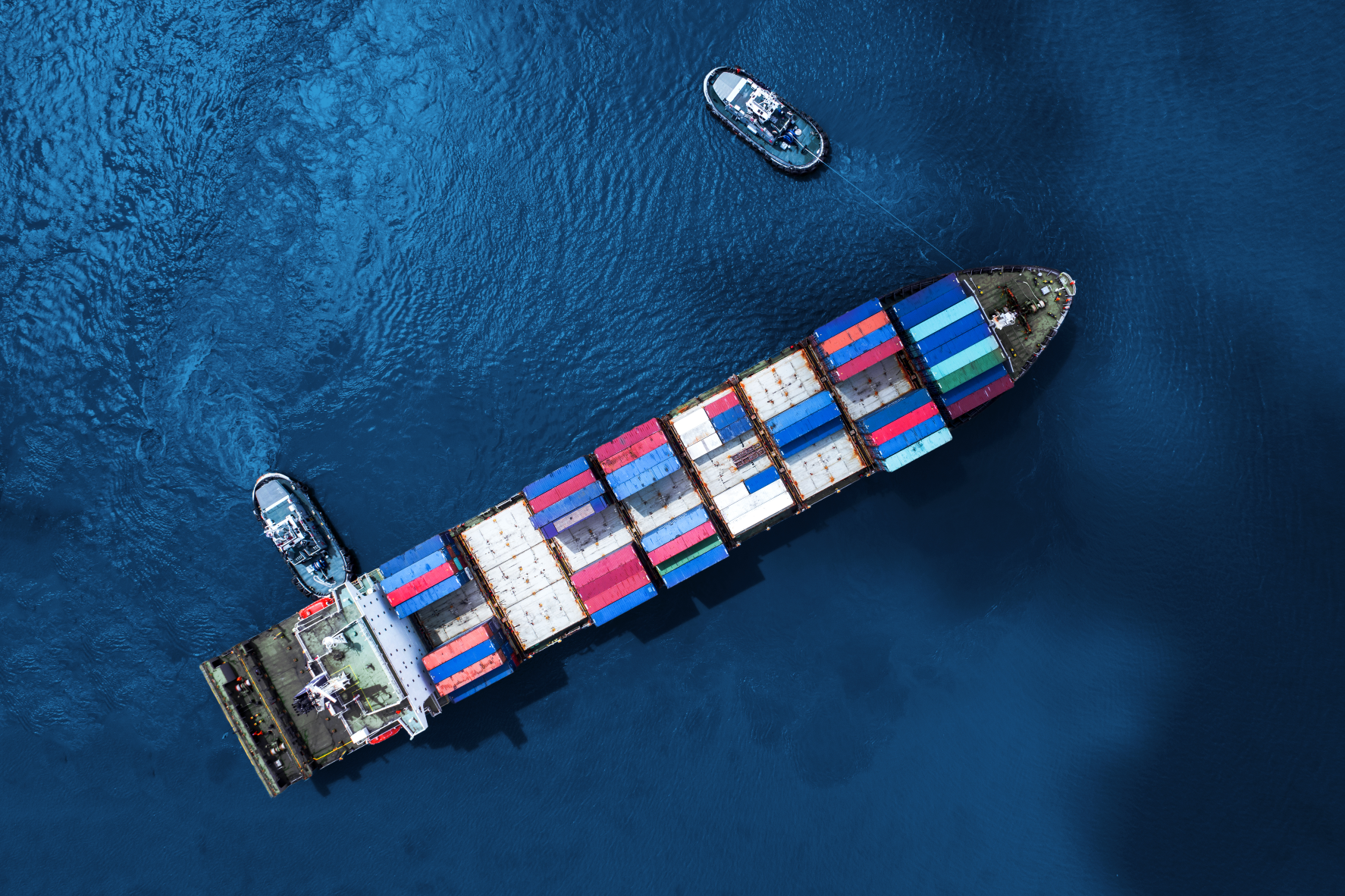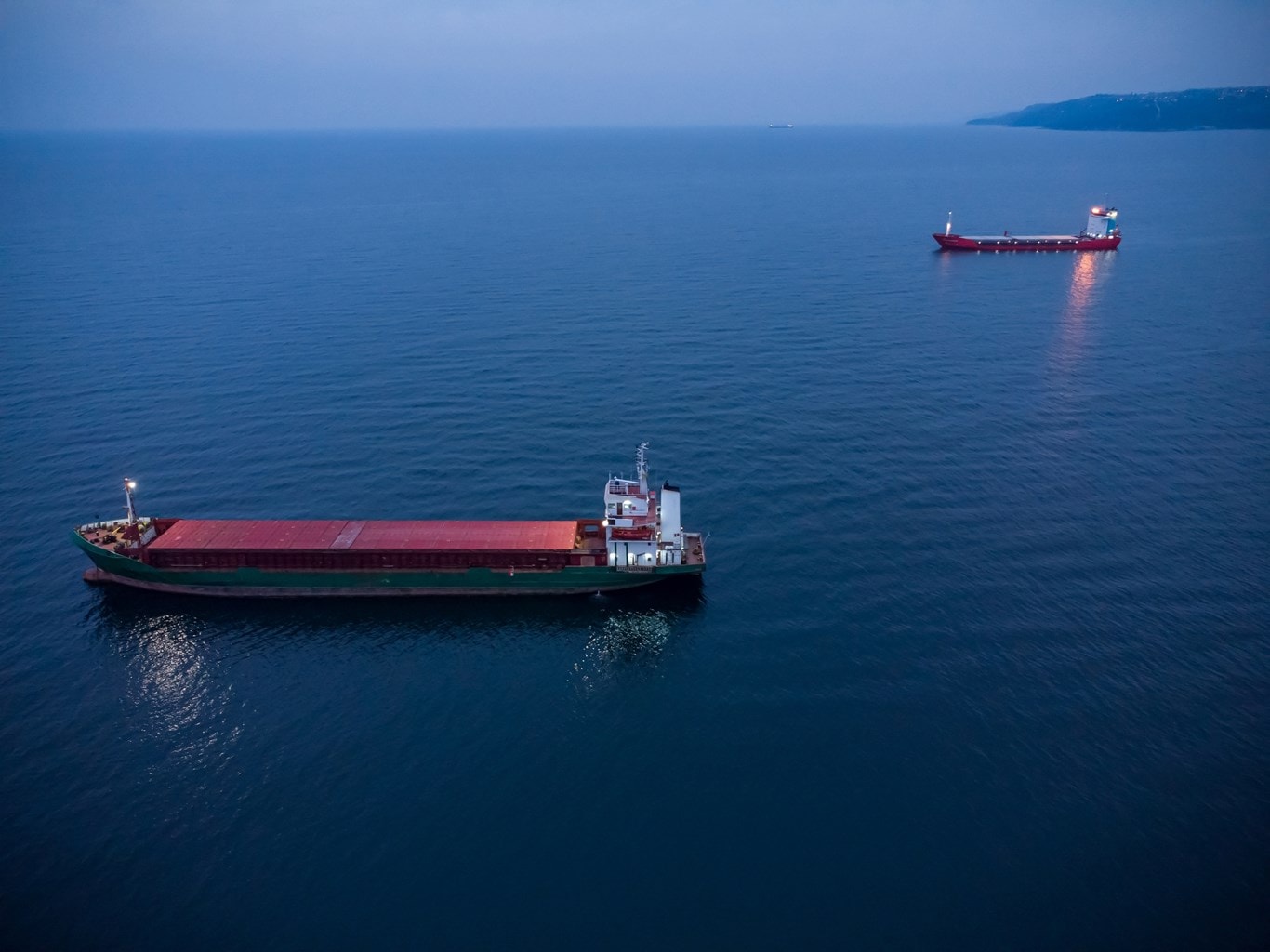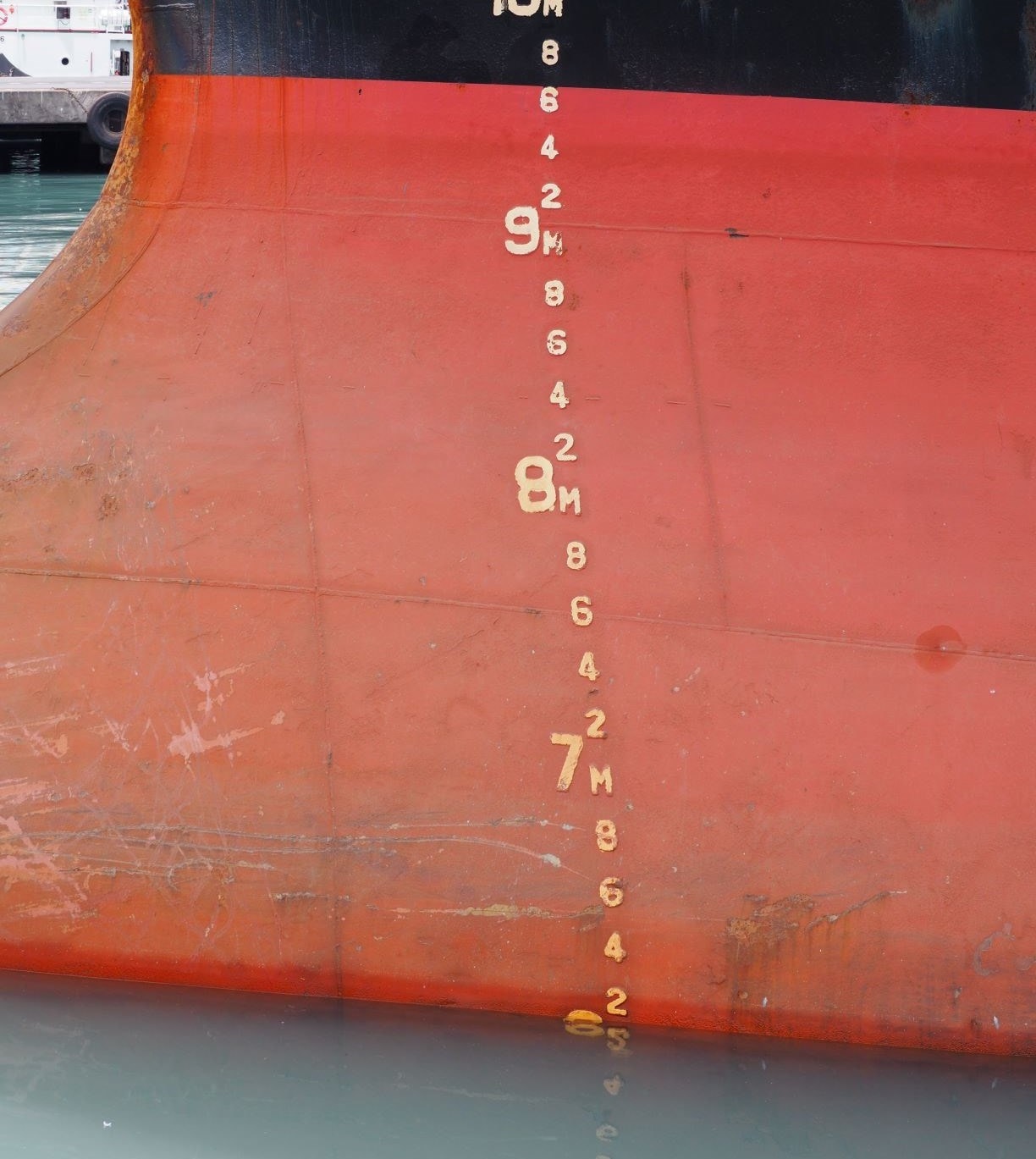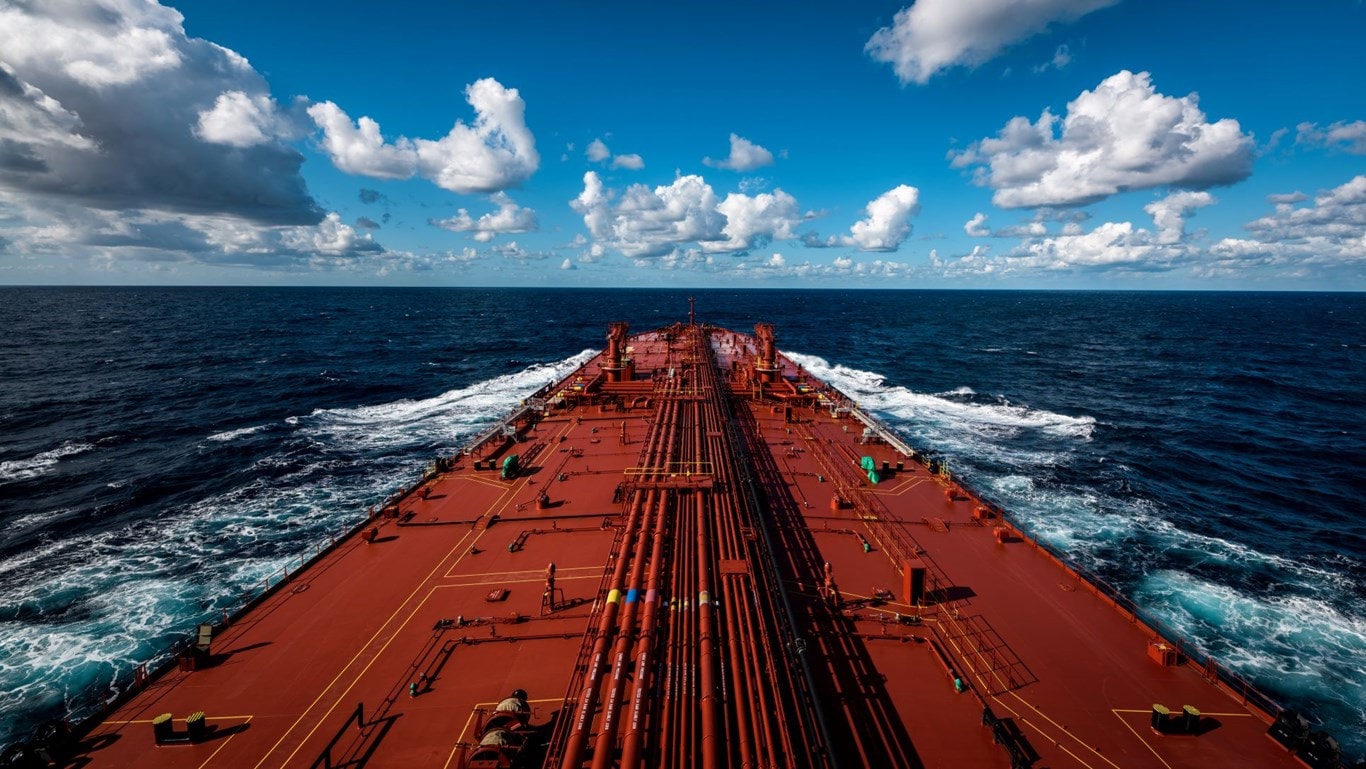
Inaccuracies in Draught Surveys
Loss Prevention Bulletin
The Club regularly receives claims arising from alleged shortages of cargo as a result of discrepancies between draught survey results.
Draughts
It is imperative that the draught
marks are read as accurately as
possible. Ideally this should be done
from a boat so that the marks can
be approached closely and read.
However, poorly painted, rusty, or draught marks covered with marine growth make reading the draught accurately problematic, therefore it must be ensured, so far as possible, that the draught marks are kept in a readable condition.
The presence of wind waves on the water surface will necessitate an estimation of the average draught by observation of the peaks and troughs of the waves against the hull.

Darkness and shadows also make accurate reading difficult; therefore good lighting will be required at night. The turn of the hull around the stern leading to elongation of draught marks being viewed from an oblique angle, especially when this has to be done from an adjacent wharf at a higher level, can lead to difficulty in accurately determining the draught.
- 68t – Handysize Bulk Carrier (10,000
– 35,000t deadweight)
- 90t – Handymax Bulk Carrier
(35,000 – 59,000t deadweight)
- 112t – Panamax Bulk Carrier (60,000
– 80,000t deadweight)
- 300t – Capesize Bulk Carrier (>
80,000t deadweight)
It is therefore advised to ensure that the inspection and maintenance of the draught marks be included in the planned maintenance system on a vessel.
Density
Although there are numerous possible causes of inaccurate dock water density, it must first be confirmed that the hydrometer being used is of the correct type. There are two types of hydrometer in use, the load line survey hydrometer, and the draught survey hydrometer, the latter being used in this case. A draught survey hydrometer, calibrated in air, measures the apparent density of the water and is used for determining the weight of the cargo on board. A load line hydrometer, calibrated in a vacuum, is used to determine the relative density of the water and determine the displacement of the vessel at a given load line.
A dock water density reading taken with a draught survey hydrometer showing 1.015 t/m3, would show 1.017 t/m3 when taken with a load line hydrometer, both are correct, the difference between the two of 0.002 is known as the “air buoyancy correction”, however as we want to determine the weight of the cargo on the vessel the density read from the draught survey hydrometer will be used.
The draught survey hydrometer is calibrated at a standard temperature. Any deviation from the standard temperature does not require a temperature correction, as the changes in the volume of the vessel and the hydrometer will generally cancel each other out. It must also be ensured that the hydrometer is calibrated regularly to ensure its accuracy, as they can become chipped, damaged and / or contaminated with a film on their surface during use, altering their mass. Hydrometer manufacturers generally recommend they are calibrated after one year, and then every two or three years thereafter.
When determining the dock water density a sample of the dock water should be taken beneath the surface of the water, clear of overboard discharges and deck runoff. In order to ensure an accurate reading the receptacle used to sample the dock water, and the hydrometer, must be clean.

When taking the reading the hydrometer must not touch the side of the receptacle and be gently spun to break the surface meniscus of the water. The density reading is then read from the hydrometer stem at the bottom of the remaining meniscus.
A number of readings should be taken from each sample, with the average of the readings determined. A number of separate dock water samples should be taken from around the vessel and measured, with the mean of all the average densities used for the draught survey. If an error is made when determining the dock water density, using a density lower than the actual density will lead to an apparent cargo shortage, with an apparent cargo surplus when a density higher than the actual density is used.
Ballast
As an example:
If we assume a single ballast tank with a 500m3 capacity. On arrival, prior to loading, the tank is overflowed and full of seawater. Therefore the assumed weight of water = 500m3 x 1.025 t/m3 = 512.5t.
However, there is 40m3 of mud in the tank.
Therefore the true picture of the tank’s contents is as follows:
Water: 460m3 x 1.025 t/m3 = 471.5t
Mud: 40m3 x 1.9 t/m3 = 76t
Total weight of tank contents = 471.5t + 76t = 547.5t
Unfactored Weights
Often weights are not deducted or allowed for when determining the cargo quantity, the commonly forgotten weights are:
- Bilge water present in the cargo holds, machinery spaces, duct keel, void spaces and the chain lockers.
- Swimming pool water.
- Anchor and anchor cable on the seabed, either when at anchor or alongside and an anchor has been deployed as part of the mooring arrangement.
- Silt and mud can accumulate in the double bottom tanks of vessels regularly ballasting in rivers or estuaries. The extra weight can give rise to an apparent increase in the cargo loaded
As 512.5t is assumed to be the weight
of ballast in the tank, the remaining
35t will appear in the constant.
On completion of loading it is assumed
the tank is empty. However, 76t
of mud remains, only 35t of which
is in the constant, the remaining 41t
will appear to be cargo loaded.
Squat
As most mariners know, squat is the bodily sinkage and trimming of a vessel making way with limited underkeel clearance. However, a vessel alongside a river berth may also be susceptible to squat, leading to inaccurate draught readings. Squat will occur when there is limited space for the water to flow between the vessel and the river bed. In order for the river water to pass between the flat bottom and the river bed there will be an increase in velocity of the water flowing past the hull, and consequently a decrease in the water pressure. The decrease in pressure leads to the ship bodily sinking and also a change of trim.
The magnitude of the bodily sinkage and change of trim is difficult to quantify, however, it will be a function of the underkeel clearance, speed of the water, the cross section of the hull in relation to the cross section of the river (blockage factor) and the shape of the hull (full form vessels are affected more). Generally full form vessels will trim by the head, and fine line vessels will trim by the stern. If a vessel is passing at the time that the draughts are being read, this may exacerbate the error due to the increased blockage of the river and consequently the vessel may trim and sink more than normal.
Further Factors
Other areas that can lead to errors in
the draught survey calculation include
the following:
Leaking tank valves – when a tank has been sounded and found to be empty, subsequent ballasting / de-ballasting operations could lead to water leaking into the tank, similarly, when ballast tanks are overflowed during discharge operations to show that they are full, water could leak out of the tank prior to the draught survey taking place.
Whilst on passage, depending on the nature of the cargo, water could migrate from the cargo to the cargo hold bilges and be subsequently pumped overboard. If water is found to be accumulating in the bilges while at sea, accurate records of the quantity of bilge water pumped overboard should be kept to help counter any subsequent cargo shortage claim.
Some vessels are susceptible to unsymmetrical hull deflection, this particularly affects smaller vessels due to their larger engine room in relation to their size which pushes the location of maximum sag forward of amidships, leading to inaccurate draught readings.
On older vessels in particular,
problems can be encountered
due to set in shell plating between
the upper wing and double bottom
ballast tanks.
Members requiring further information should contact the Loss Prevention department.
The position of the hatchcovers can affect the deflection of the hull, particularly on smaller vessels when the open hatch covers may be stowed at one or both ends of a single hold. For draught surveys on all vessels it is recommended that the hatches remain closed to ensure consistency.
Whilst alongside any bunkering, taking of potable water, and discharge of sludge or oily water should be considered when completing the final draught survey.
Where there is any notable difference in the constant between loading and discharge, then this is an indicator that there is an error somewhere in the draught survey, and this should be thoroughly investigated.
Throughout a cargo voyage, the constant should be, as the name suggests, fairly constant. In the event of a cargo discrepancy arising as a result of a draught survey, deck officers are advised to consider the possibility that one or more of the foregoing factors may have contributed to the difference. In particular any substantial change in the constant should be viewed with suspicion and investigated.
